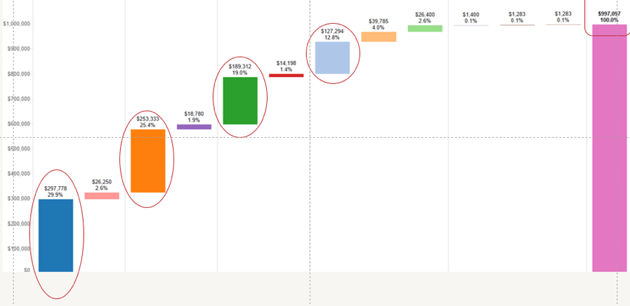
Over the last two weeks, we’ve covered an introduction to what the Quantified Value Proposition (QVP) is, why it’s important to businesses that want to stand out from the fierce competition they’re facing, and how to go about creating one.
Now, we’re going to take you inside a real-world case study involving the creation and execution of a QVP within a large multinational organization.
Setting the Stage
The company in question has a footprint in many different verticals and produces product lines for many target markets. However, this case study focuses specifically on efforts to articulate the value, and accordingly package and price, of a proprietary software package.
Although this case study happens to involve a large corporation, the principles and processes described are applicable to any QVP development process - large or small, broad or highly focused.
Primary Challenges
- The client needed to be able to effectively sell their software solution to buyers who were facing a number of different pain points and had plenty of vendors to choose from.
- The sales team needed to be able to effectively sell the value of the solution.
- Deals had been recently lost because of the complexity of the offering and the price.
Initial Considerations
Approaching this project, the following questions outlined EMM Group’s marketing framework for accomplishing the client’s goals:
- What is the unique and compelling value proposition?
- How do we incentivize rapid acquisition of assets and get them under management of the software?
- How do we create pricing that is simple- both for internal and external audiences – to understand and apply?
- How do we create a model that is scalable across different versions of the software for each industry vertical?
- How do we prevent inconsistent pricing to the same customer?
- How do we package the software for pricing – app, service, micro-service?
- What should be our price metrics - $/asset; $/hour, $/user?
- How do we price for the use of the underlying platform and ensure we are making money?
Based on the answers to those and related questions, we built the following plan of attack:
- Focus on identifying and quantifying ways in which the software can add unique value to target customers and use that as the basis of pricing.
- Identify value-based segments so that offering tiers (and price points) will track with increasing relevant value.
- Build pricing by recognizing all the elements of a software revenue model beyond the software itself (e.g. maintenance/enhancements, hosting, data, etc.).
- Hinge pricing elements such as price metrics and offering tiers to value accrual for customers.
- Use a build-measure-learn rhythm to rapidly and systematically identify and validate value hypothesis.
Answering the questions and applying the principles listed above allowed us to create a unique QVP that accomplished that goal effectively in four steps.
Step One: Identify and Prioritize Value Drivers
We began by identifying the key value drivers and categories our client’s customers were most interested in. In some cases, our research brought up pain points and concerns that weren’t even on our radar. In other cases, it validated what we had already assumed would be of value to the customer.
This is an exercise every marketing team should be carrying out routinely, but it is unfortunately easy - especially for large, long-standing companies - to grow stagnant in their understanding of their customers. Properly reviewing these value drivers and updating them created the optimal foundation for our QVP.
Step Two: Identify How the Solution Relates to Those Drivers
In designing the offer, we arranged the solutions into tiers that could effectively offer value to the customer commensurate with their use of the software.
We also created “fences” to clearly delineate one offering tier from another, which alleviated confusing overlap or contradiction to enable quick, clear decisions.
Finally, in designing the offer, we established how the conclusions we arrived at would be validated in the model. Validation is a key to creating a usable QVP. Without it, even the best planned QVP can appear to be an educated guess.
Step Three: Build a Value Algorithm
After identifying value drivers and categories, prioritizing them effectively, and relating them to the solution we wanted to present, we were able to establish value algorithms around each. These algorithms essentially connected each value driver to a realistic equation, making it possible to tie real-world dollars and cents to the unique value our client’s solution provided.
Step Four: Estimate the Dollar Value for Each Algorithm
Pulling together both historical and best-guess estimates of the current situation across their large customer and prospect spectrum, we were able to create realistic financial estimates to plug into each value algorithm.
With these figures as a starting point, the QVP was complete and could be shared with the sales team for release into the real world. From there, as customers and prospects are interviewed, the algorithms and figures are being continually fine tuned so that the QVP becomes more accurate as it progresses.

Specific Applications of the QVP in this Case
Price is a huge component in establishing value. Although we wanted to take the decision-making emphasis off price, the price needed to be logically in line with the value defined for the product.
One of the most important factors to consider, beyond ensuring that our pricing appeared reasonable and remained profitable for the client, was whether or not the sales team would be able to effectively answer the inevitable customer question, “how did you arrive at that price.”
Accomplishing that involved defining the value capture rate as well as the value-price landscape.
Finally, with the full QVP and pricing framework established, we determined how to handle exceptions so the sales department still had adequate leeway to get to “yes” without being confined to exact rules.
Ongoing conversation with Sales helped us establish a discounting allocation that could be used to “sweeten the pot” without sacrificing value or significant profit margin.
We also decided which customer segments were the best to target first in light of the most influential value drivers established earlier.
By knowing which segments to target and how much leeway was available, sales was provided with enough ammunition to attack that segment effectively right out of the gate.
The End Results
In this case, the QVP and related value-focused framework had a profound effect on the product launch. Some of the success factors the client identified were:
- Using a value-based approach addressed contradicting opinions on how the offering should be designed and priced for the easiest to sell to customers.
- Quantifying the value created the compelling story the commercial team needed to take the offering to market.
- Providing flexibility and willingness to go the extra mile delivered a complete solution.
- Validating hypothesis through VOC research gave valuable insights and gained confidence in recommendations.
But perhaps most telling were these great testimonials directly from the client:
“This project has convinced me that value-based pricing is the best way to find the value and create pricing for software.” – Chief Marketing Officer
“Great analysis, unique metric to use for pricing and deliverables that allowed other product teams to follow in our footsteps…. Everyone was impressed with how quickly EMM got up to speed.” – Project Leader
This case study helps to solidify the value of creating a QVP and surround that powerful sales tool with the right framework and infrastructure to sell it effectively to the customer. There is no greater tool in the salesperson’s toolbox than irrefutable evidence of the value of what they’re selling.
To learn more about our client successes, read case examples. To learn why a quantified value proposition is essential to marketing success, register for our webinar:


